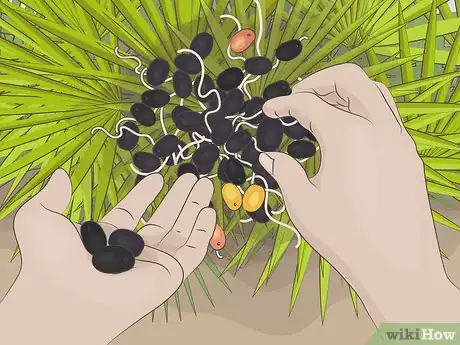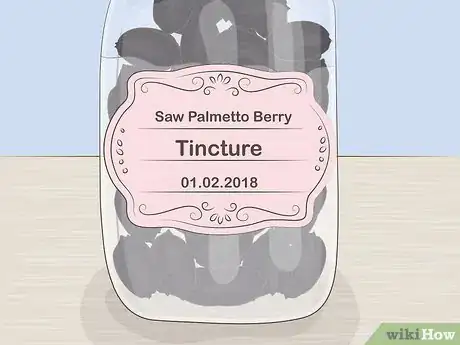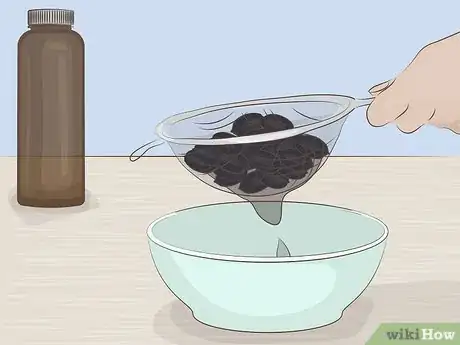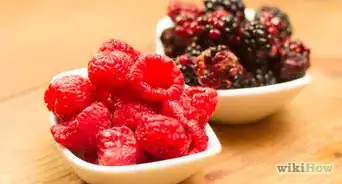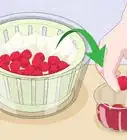This article was co-authored by wikiHow Staff. Our trained team of editors and researchers validate articles for accuracy and comprehensiveness. wikiHow's Content Management Team carefully monitors the work from our editorial staff to ensure that each article is backed by trusted research and meets our high quality standards.
wikiHow marks an article as reader-approved once it receives enough positive feedback. In this case, 96% of readers who voted found the article helpful, earning it our reader-approved status.
This article has been viewed 64,515 times.
Learn more...
Saw palmetto berries are the fruits of a small palm bush that grows in the Southeastern United States. Though they were eaten by Native American peoples, the berries are consumed today mainly as a tonic for health. They are believed to contain compounds that can treat urinary tract infections, benign prostate conditions, and male pattern baldness. You can eat the berries raw, or make them into a tincture or tea.
Steps
Eating Saw Palmetto Berries Raw
-
1Find a saw palmetto plant growing wild. Identify the saw palmetto by its small size of 7 to 10 feet (2.1 to 3.0 m), horizontal snaking trunk, and round crown of large, fan shaped leaves. Find the saw palmetto bush located in lowlands and savanna scrubs of the subtropical Southeastern United States, most commonly along the south Atlantic and Gulf Coasts. Saw palmetto is especially common in Florida.[1]
- Look for berries in the fall months of September and October when the fruits are ripe. You will know they are ripe by their dark brown to black color.
- Make sure you find a plant that is wild and growing on public land. Saw palmettos are a cash crop in Florida and you can be fined if you are caught picking berries that are being commercially farmed.
-
2Pick a few of the ripe black berries. You can find the berries at the base of the palm fronds. Be careful when you reach in to pick the berries. The “saw” of saw palmetto refers to the sharp prickly frond stalks.[2]Advertisement
-
3Eat the berry slowly to get used to the strong flavor. Saw palmetto berries are similar in size and oiliness to a black olive. Like an olive, they have a pit. Take small nibbles of the sweet, peppery, and pungent fruit.
- If you do pop the whole fruit into your mouth, remember that there is a pit.
- The strong flavor of the berries was described in 1692 by shipwrecked Quakers as the flavor of rotten cheese steeped in tobacco juice.[3] Others say the taste is like a sweet, especially strong bleu cheese.
Brewing a Saw Palmetto Berry Tincture
-
1Put 1⁄2 pound (0.23 kg) dried saw palmetto berries in a 1 quart (0.95 l) mason jar. Purchase dried saw palmetto berries online or at your local health food store. Usually the berries are already chopped up into small pieces. If not, chop the berries into quarter pieces or smaller.
-
2Cover the berries with grain alcohol. Use 80 or 100 proof vodka or gin. It is important that the alcohol is made from grain, so check the label. Don’t worry about brand name, just get the cheap kind. Once the jar is full, tighten the lid and shake the mixture up for 30 seconds.[4]
- As an alternative to grain alcohol, you can use unfiltered apple cider vinegar for your tincture.
-
3Label and date the jar. Place a label on the mason jar and make note of the contents and the date. This is especially important if you plan on making multiple tinctures at a time.
-
4Steep the mixture in a cool, dark place for 6 weeks to 3 months. For the first two weeks, shake the mixture twice a day. After that, let it sit. Over time, the alcohol will extract the properties of the berries. The longer you let it sit, the stronger the tincture will be. However, there is no real benefit after the 3-month mark.[5]
-
5Strain the liquid from the berries. Pour the mixture through a mesh strainer or colander with a bowl underneath to catch the liquid. Discard the berries. Place the liquid in a dark bottle for storage.
- You can purchase dark colored bottles with droppers online or at a health food store.
-
6Take 2-3 spoonfuls of the tincture a day as a health tonic. This tincture can be taken for general prostate health (including treatment for enlarged prostate), male pattern baldness, and urinary tract infections. It is important to see a doctor for specific symptoms to rule out any serious conditions that may require treatment.
Making Saw Palmetto Berry Tea
-
1Boil 1 cup (240 ml) of water. Place the water in a tea kettle or pot and turn the burner to high. Wait for a full rolling boil and then pour it into your cup. It’s always best to make your tea with fresh, filtered water. Don’t use water that has already been boiled once.
-
2Place 1 tablespoon (15 ml) dried saw palmetto berries in a tea ball. Purchase dried saw palmetto berries online or at the health food store. Usually the berries are already chopped up into small pieces. If not, chop the berries into quarter pieces or smaller. Place your filled tea ball into your cup of boiled water.
-
3Cover your cup and let the saw palmetto berries steep. Wait 20-30 minutes. The longer you steep, the stronger your tea will be, both in flavor and medicinal strength.[6]
-
4Flavor the tea to your taste. If this is your first time tasting saw palmetto tea, taste it without any additions first. Saw palmetto berries are considered sweet, but they are also pungent. You may want to use sugar, honey, or milk to create a flavor that you will enjoy.
Things You’ll Need
Brewing a Saw Palmetto Berry Tincture
- Quart size mason jar
- Dried saw palmetto berries
- Grain alcohol or unfiltered apple cider vinegar
- Mesh strainer or colander
- Label
- Dark bottle
Warnings
- Saw palmetto can cause digestive symptoms or headaches.[7]⧼thumbs_response⧽
- The consumption of saw palmetto berries is not recommended for pregnant or nursing women.⧼thumbs_response⧽
- The use of saw palmetto to treat medical conditions has not been validated by the FDA. If you have any serious health concerns, you should always check with your health care practitioner before self-administering herbs.[8]⧼thumbs_response⧽
References
- ↑ https://selby.org/saw-palmetto-palm-family/
- ↑ https://selby.org/saw-palmetto-palm-family/
- ↑ http://www.eattheweeds.com/saw-palmetto-saga-3/
- ↑ https://www.youtube.com/watch?v=gYbROufzvAs
- ↑ https://www.youtube.com/watch?v=gYbROufzvAs
- ↑ https://www.youtube.com/watch?v=20wMafsKd38
- ↑ https://nccih.nih.gov/health/palmetto/ataglance.htm
- ↑ https://nccih.nih.gov/health/palmetto/ataglance.htm

